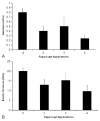Papain-gel degrades intact nonmineralized type I collagen fibrils
- PMID: 20205185
- PMCID: PMC2939036
- DOI: 10.1002/sca.20171
Papain-gel degrades intact nonmineralized type I collagen fibrils
Abstract
Papain-gel has been utilized as a chemo-mechanical material for caries removal due to its ability to preserve underlying sound dentin. However, little is known about the effect of the papain enzyme on intact type I collagen fibrils that compose the dentin matrix. Here we sought to define structural changes that occur in intact type I collagen fibrils after an enzymatic treatment with a papain-gel. Intact and nonmineralized type I collagen fibrils from rat tail were obtained and treated with a papain-gel (Papacarie) for 30 s, rinsed with water and imaged using an atomic force microscope (AFM). Additionally, polished healthy dentin specimens were also treated using the same protocol described above and had their elastic modulus (E) and hardness (H) measured by means of AFM-based nanoindentation. AFM images showed that the papain-gel induced partial degradation of the fibrils surface, yet no rupture of fibrils was noticed. The distinction between gap and overlap zones of fibrils vanished in most regions after treatment, and overlap zones appeared to be generally more affected. Mechanical data suggested a gradual decrease in E and H after treatments. A significant two-fold drop from the values of normal dentin (E=20+/-1.9, H=0.8+/-0.08 GPa) was found after four applications (E=9.7+/-3.2, H=0.24+/-0.1 GPa) (P<0.001), which may be attributed to the degradation of proteoglycans of the matrix. In summary, this study provided novel evidence that intact nonmineralized type I collagen fibrils are partially degraded by a papain-gel.
(c) 2010 Wiley Periodicals, Inc.
Figures



References
-
- Banerjee A, Watson TF, Kidd EA. Dentine caries excavation: a review of current clinical techniques. Br Dent J. 2000;188:476–482. - PubMed
-
- Bussadori SK, Castro LC, Galvao AC. Papain gel: a new chemo-mechanical caries removal agent. J Clin Pediatr Dent. 2005;30:115–119. - PubMed
-
- Correa FN, Rocha Rde O, Rodrigues Filho LE, Muench A, Rodrigues CR. Chemical versus conventional caries removal techniques in primary teeth: a microhardness study. J Clin Pediatr Dent. 2007;31:187–192. - PubMed
-
- Correa FN, Rodrigues Filho LE, Rodrigues CR. Evaluation of residual dentin after conventional and chemomechanical caries removal using SEM. J Clin Pediatr Dent. 2008;32:115–120. - PubMed
Publication types
MeSH terms
Substances
Grants and funding
LinkOut - more resources
Full Text Sources
Miscellaneous
